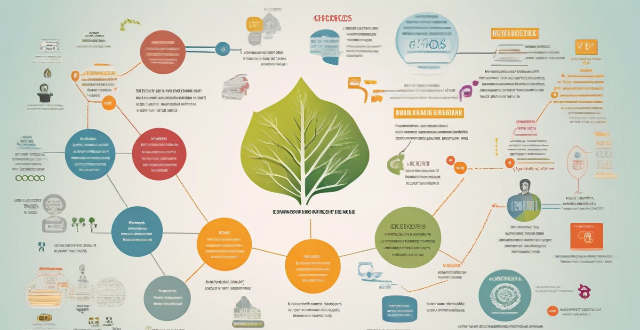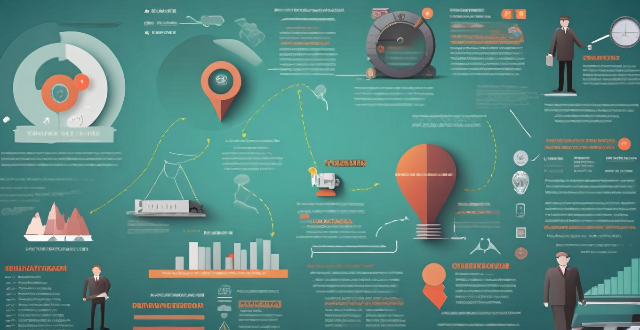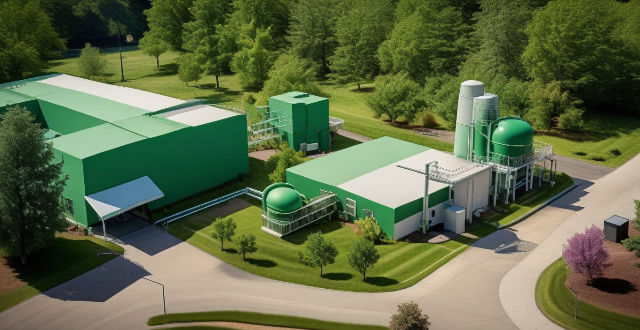Economic Circular

How can circular economy policies contribute to economic growth ?
Circular economy policies can drive economic growth through innovation, job creation, and sustainable business models. By promoting resource efficiency, new markets, and sustainable supply chains, these policies reduce waste management costs and enhance corporate image. Government incentives further support businesses in adopting circular practices, mitigating risks from resource shortages and commodity volatility. Ultimately, the circular economy contributes to long-term economic stability by fostering renewable resource use and reducing waste.

Why is the concept of a circular economy important for sustainable development ?
The circular economy, an economic system that minimizes waste and maximizes resource use, is crucial for sustainable development. It helps reduce resource depletion, waste, and pollution, while providing economic benefits, fostering innovation, and promoting social equity. By transitioning to a circular economy, we can ensure long-term sustainability and preserve resources for future generations.

How do circular economy policies promote sustainability ?
Circular economy policies promote sustainability by reducing resource consumption, minimizing waste and pollution, fostering economic growth within ecological limits, creating social benefits and jobs, and encouraging systemic change and collaboration. Key practices include promoting product longevity, eco-design, zero-waste initiatives, clean technologies, circular business models, green jobs training, and multi-stakeholder cooperation. These policies aim to transition towards a more sustainable future by keeping resources in use for as long as possible while incurring the least waste.

What challenges do countries face in implementing circular economy policies ?
Implementing circular economy policies is a complex process that countries face numerous challenges. These include lack of awareness and understanding, economic and industrial structure, legal and regulatory framework, market conditions and business practices, as well as social and cultural factors. Addressing these challenges is crucial for the successful implementation of circular economy policies, which can bring significant environmental and socioeconomic benefits.

What are some successful examples of circular economy policies ?
The circular economy is a sustainable economic model that aims to minimize waste and pollution by keeping resources in use for as long as possible. Successful examples of circular economy policies include the European Union's Circular Economy Package, Netherlands' National Circular Economy Programme, China's Circular Economy Promotion Law, Japan's Sound Material-Cycle Society Act, and state-level initiatives in the United States. These policies focus on waste reduction, resource efficiency, extended producer responsibility, product stewardship, and public-private partnerships to promote a more sustainable future.

How does a circular economy differ from a linear economy ?
The circular and linear economies are distinct models with different approaches to resource use, waste management, and sustainability. The linear economy follows a one-way flow of materials, extracting resources, processing them, consuming, and discarding as waste, focusing on continuous growth through increased consumption. In contrast, the circular economy aims to minimize waste and pollution by keeping resources in use for as long as possible through recycling, reusing, and regenerating products and materials. It focuses on creating a restorative and regenerative system by design. Key differences include the flow of resources, where the linear economy moves resources in a straight line from extraction to disposal, while the circular economy keeps resources in loops through recycling and regeneration. Economic growth is tied to increased consumption and throughput of resources in a linear economy, whereas it is decoupled from finite resources in a circular economy, emphasizing quality, longevity, and efficiency. Environmental impact is high in a linear economy due to excessive resource extraction, energy use, and waste accumulation, leading to pollution, habitat destruction, and climate change. In contrast, the circular economy has a lower environmental impact because it reduces waste and pollution by extending the life cycle of products and materials. Job creation and innovation are also different, with the linear economy centering jobs around resource extraction and processing, while the circular economy encourages job creation in recycling, refurbishing, and designing for longevity and recyclability. Transitioning from a linear to a circular economy presents challenges such as changing consumer behavior, investing in new technologies, redesigning supply chains, and updating legislation to support circular practices. However, it also offers opportunities such as reducing dependence on finite resources, stimulating green jobs and innovation, improving environmental quality, and fostering resilience against resource price volatility. Overall, the circular economy offers a pathway towards a more sustainable and resilient future for our planet.

What role do consumers play in promoting a circular economy ?
The text discusses the crucial role of consumers in promoting a circular economy, which is an economic system aimed at reducing waste and maximizing the use of resources. Consumers can contribute to this process by reducing their consumption, reusing and recycling products, and supporting sustainable brands. By making conscious choices and taking actions towards sustainability, consumers can help create a more efficient and eco-friendly economic system.

What is a circular economy and how does it work ?
Circular Economy: An economic system designed to minimize waste and pollution by reducing, reusing, recycling materials. Key principles include reduce, reuse, recycle, regenerate, and share. It works through design for the cycle, closed-loop systems, industrial symbiosis, rethinking consumption, and government policies. Benefits are environmental sustainability, resource efficiency, economic opportunities, cost savings, and resilience. Challenges include economic disruption, infrastructure changes, consumer behavior, and policy alignment.

What is a circular economy policy ?
A circular economy policy is a set of regulations and guidelines aimed at transitioning from a linear to a circular economic model. This approach focuses on reducing, reusing, recycling, and recovering resources to minimize waste and pollution while creating economic opportunities. Key characteristics include reducing resource input, optimizing product lifespan, encouraging reusable goods, supporting second-hand markets, ensuring material recovery, investing in recycling infrastructure, facilitating energy and nutrient recovery, fostering designs for deconstruction, and promoting Cradle to Cradle approaches. Benefits of such policies include resource efficiency, waste reduction, job creation, increased resilience, and innovation. Examples include extended producer responsibility, deposit return schemes, green procurement, and resource taxation.

What are the main challenges faced by industries when moving towards a circular economy ?
The transition towards a circular economy presents several challenges for industries. These can be broadly categorized into economic and financial barriers, technological and innovation hurdles, market and supply chain complexities, regulatory and policy obstacles, organizational culture and capabilities, and informational and transparency issues. High upfront costs, lack of economic incentives, uncertain return on investment, limited recycling technologies, scaling up difficulties, data and knowledge gaps, fragmented supply chains, consumer behavior, markets for recycled materials, inconsistent policies, weak enforcement, legislative uncertainty, resistance to change, skills and competencies, top-down vs. bottom-up approaches, product lifecycle transparency, and eco-labeling standards are some of the main challenges faced by industries moving towards a circular economy. Collaborative efforts between government, industry, academia, and civil society are crucial to overcome these challenges.

How can circular economy policies be applied to different industries ?
The circular economy is a concept aimed at reducing waste and maximizing resource use across various industries. Here are key ways to apply circular economy policies in different sectors: 1. **Manufacturing**: Implement resource efficiency, remanufacturing, design for disassembly, and sustainable supply chain management. 2. **Agriculture**: Adopt crop rotation, composting, precision farming, and aquaponics systems. 3. **Energy**: Utilize renewable energy sources, improve energy efficiency, implement waste-to-energy solutions, and develop smart grids. 4. **Fashion**: Use sustainable materials, promote rental and secondhand markets, establish closed-loop production, and ensure transparency and traceability. 5. **Food and Beverage**: Reduce food waste, minimize packaging, upcycle byproducts, and conserve water. 6. **Construction**: Employ modular design, use green building materials, incorporate energy-efficient designs, and plan for deconstruction.

In what ways can technology support the growth of a circular economy ?
Technology plays a crucial role in supporting the growth of a circular economy by enabling efficient use of resources, reducing waste, and promoting sustainable practices. It can improve resource management, reduce waste through recycling technologies and 3D printing, promote sustainable practices with carbon footprint calculators and green software, support circular business models like sharing economy platforms and product as a service models, and raise awareness about sustainable practices through online courses and social media campaigns.

What is the relationship between circular economy policies and climate change mitigation ?
The circular economy (CE) is an economic system that promotes sustainable development by reusing and recycling materials, minimizing waste, and reducing the need for new raw material extraction. CE policies contribute to climate change mitigation by decreasing greenhouse gas emissions, enhancing energy efficiency, supporting renewable energy, promoting sustainable practices, creating green jobs, and encouraging systemic changes towards sustainability. Challenges to implementing CE policies include modifying economic incentives, establishing supportive regulations, advancing technological innovation, and changing consumer behavior.

How do circular economy principles apply to supply chain management, and what benefits do they bring in terms of climate change adaptation ?
The circular economy is a regenerative system that replaces the "end-of-life" concept with reducing, alternatively reusing, sharing, repairing, refurbishing, remanufacturing and recycling existing materials and products. This approach minimizes waste and pollution, extends product lifecycles, and helps to mitigate climate change. In supply chain management, applying circular economy principles can bring significant benefits in terms of climate change adaptation. The key principles of circular economy in supply chain management include design for recycling and reuse, extended producer responsibility (EPR), circular procurement, collaborative partnerships, resource efficiency, digital tracking and transparency, reduction in greenhouse gas emissions, conservation of natural resources, increased resilience, innovation and economic opportunities, and improved waste management. By adopting these practices, organizations can contribute to a more sustainable economy that reduces environmental impacts and builds resilience against the effects of a changing climate.

How can we balance economic growth with environmental sustainability ?
Balancing economic growth with environmental sustainability requires a multifaceted approach that includes promoting green infrastructure and renewable energy, encouraging sustainable business practices, fostering innovation and technology development, educating and engaging stakeholders, and implementing policies and regulations. By taking these steps, we can create a more sustainable future where economic prosperity coexists with environmental well-being. Achieving this balance will require ongoing effort from all sectors of society, including governments, businesses, communities, and individuals alike.

How can climate and environmental policies be designed to promote sustainable economic growth ?
This text discusses the integration of environmental considerations into economic planning, promoting renewable energy sources, encouraging energy efficiency, supporting green infrastructure, promoting circular economy practices, strengthening environmental regulations, and fostering international cooperation to promote sustainable economic growth.

Can you provide some examples of successful circular economy models ?
The circular economy is a regenerative system that aims to keep resources in use for as long as possible, extracting the maximum value from them while incurring the least waste. Some examples of successful circular economy models include: 1. Reuse and recycling programs such as IKEA's furniture recycling program and Patagonia's Worn Wear program. 2. The sharing economy, where underutilized assets are shared among people, such as Airbnb and Zipcar. 3. Product as a Service (PaaS), where companies like Xerox and Philips offer their products as a service rather than selling them outright. 4. Industrial symbiosis, where industries work together to create a sustainable ecosystem by exchanging waste materials and resources, such as Kalundborg Symbiosis and Chalmers Hamn. These models demonstrate how businesses can operate sustainably by designing out waste and pollution, keeping products and materials in use, and regenerating natural systems.

What are the benefits of implementing circular economy policies ?
Implementing circular economy policies brings environmental, economic, and social benefits. Environmentally, it reduces resource consumption, lowers greenhouse gas emissions, and improves waste management. Economically, it creates jobs, saves costs, and drives innovation. Socially, it ensures resource security, improves public health, and empowers consumers. Overall, adopting these policies shifts towards a sustainable system that prioritizes long-term planetary health.

How can circular economy policies improve resource efficiency ?
Circular economy policies enhance resource efficiency by promoting sustainable practices like product redesign, encouraging reuse and sharing, maximizing recycling, reducing waste, supporting innovation, and building capacity for sustainable practices.

What are the benefits of transitioning to a circular economy ?
The transition to a circular economy offers significant environmental, economic, and social benefits. These include reduced resource depletion, lower emissions, enhanced biodiversity, job creation, cost efficiency, innovation stimulus, sustainable consumption, equity and inclusivity, and healthier communities.

How does waste reduction contribute to a circular economy ?
The transition to a circular economy is significantly influenced by waste reduction, which encompasses various strategies like reusing products, recycling materials, and promoting resource efficiency. These practices help in conserving natural resources, reducing pollution, creating economic opportunities, and fostering sustainable consumer behavior. Governments and businesses play a crucial role in driving waste reduction through policy initiatives, technological innovations, and sustainable supply chain management. Community engagement and public awareness further support this shift towards a more sustainable economic model.

What role do governments play in promoting circular economy policies ?
Governments play a critical role in promoting circular economy policies by providing the necessary framework and incentives for sustainable practices. This involves regulatory measures, economic instruments, public awareness campaigns, collaboration, and research and development to reduce waste, conserve resources, and foster a closed-loop system where materials are reused and recycled.

How can circular economy policies help achieve the United Nations Sustainable Development Goals ?
Circular economy policies align with the United Nations Sustainable Development Goals by reducing resource depletion, minimizing waste and pollution, promoting energy efficiency, creating jobs, enhancing resource efficiency and sustainable infrastructure, fostering global partnerships, supporting sustainable communities, encouraging innovation and education, and contributing to climate action. These policies offer a comprehensive approach to achieving sustainability by promoting a system that is restorative and regenerative by design, providing economic and social benefits and being a critical component of global sustainable development efforts.

What impact do circular economy policies have on employment opportunities ?
Circular economy policies can have a significant impact on employment opportunities across various sectors, with both positive and negative effects. Job creation in recycling and waste management, growth in green technologies, support for small businesses and startups, and education and training programs are some of the positive impacts. However, displacement of workers in traditional industries, skill gaps and reskilling challenges, and economic disruption and market uncertainty are some of the negative impacts. Policymakers should consider both the positive and negative impacts when designing and implementing circular economy strategies to ensure that overall employment opportunities are maximized while still achieving environmental goals.

How does a circular economy contribute to waste reduction and resource conservation ?
The circular economy model promotes waste reduction and resource conservation by advocating for the reuse and recycling of materials, reducing raw material extraction, extending product lifecycles, treating waste as a resource, encouraging the sharing economy and digital services, improving resource efficiency, promoting biodegradable and renewable resources, raising consumer awareness, and supporting regulatory policies. This approach challenges traditional linear economic models and offers a sustainable solution to address environmental issues related to waste and resource depletion.

Can circular economy policies help reduce waste and pollution ?
Circular economy policies can significantly reduce waste and pollution by promoting reuse, recycling, and cleaner production methods. These policies incentivize businesses to design products that are easier to maintain and recycle, support sustainable business models like leasing and Product as a Service (PaaS), and encourage consumers to make environmentally friendly choices. Through such measures, the need for new raw materials decreases, energy consumption is reduced, and waste is diverted from landfills, all of which contribute to lower emissions and a cleaner environment.

Can economic growth be compatible with sustainable development ?
Economic growth and sustainable development can coexist through strategies such as promoting green economies, inclusive growth, regulation and policy, technological innovation, and international collaboration.

How can businesses adopt circular economy policies ?
Businesses can adopt circular economy policies by designing for longevity and reuse, reducing waste, establishing closed-loop supply chains, implementing extended producer responsibility, innovating with circularity in mind, engaging stakeholders, and measuring and reporting progress. These strategies not only contribute to sustainability but also provide cost savings, risk reduction, and new business opportunities.

How can businesses adopt circular economy principles in their operations ?
Businesses can adopt circular economy principles in their operations to promote sustainable growth and reduce environmental impact through various strategies such as designing durable products, reducing waste, establishing closed-loop systems, fostering collaborative consumption, educating stakeholders, innovating sustainably, ensuring supply chain transparency, utilizing financial mechanisms, advocating for supportive policies, and continuously improving processes. These practices help businesses minimize waste, extend product lifespans, and contribute to a more sustainable future.